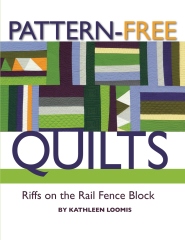Two interesting discussions on my email lists last week about quilters who were hurt, angry and/or confused about how other people responded to their work.
Quilter A wrote that she published a pattern for a quilt design that she has made several times; it's been selling well on Craftsy. But a local quilt shop advertised her design as its block of the month, mentioning that they got the photo from Pinterest and made their own pattern from it "based on a quilt made by Quilter A in 2002."
Quilter A contacted the shop owner, said there is indeed a pattern, and would they please have their students buy the pattern if they want to make the block. The shop owner refused and things got ugly.
Quilter B wrote that she just got an email from somebody who saw a photo of her quilt on Pinterest and fell in love with it. What kind of fabric did she use? "I intend to make it and would find it helpful if I had a starting point in my quest for the fabric."
Quilter B didn't know what to do next. "I can't decide if I should laugh? be angry? or feel honored that she likes it that much? I am at a loss for words." A complicating factor: the Pinterest photo has been pinned and repinned many times over the last several years, usually identified as having been made by somebody other than Quilter B.
I was struck by the two unrelated tales and realized there is a wide gulf in expectations and understanding between people who make original designs and people who generally work from other people's designs. And there's also a gulf among the people who make original designs! Some of those people want to monetize their designs and techniques, through patterns, workshops, books, etc. Some are happy to share their designs and techniques, even without getting money for it. But other people are jealous of their designs and techniques, getting upset and offended if somebody wants to make copies or attempt the same technique or even take a picture.
Now think of the other group -- people who don't make original designs. How are they to know which kind of person they're dealing with when they see a quilt they like? Is this a quilt they're allowed and encouraged to copy, or one they mustn't touch with a ten-foot pole? The presence of a dollar sign and the word "pattern" or "kit" is a clue, but not always. And some people may not even realize that a quiltmaker regards her work as original art, rather than just a nice piece of handmade decor. They may not even realize there is a certain etiquette regarding original designs, let alone understand the nuances of that etiquette.
Of course, the unindicted co-conspirator in both these stories is Pinterest, but we might equally blame Google images. I bet we have all found our own work pinned to somebody else's board, or popping up when we google some other artist. Often the work is not identified (it should be a felony to post photos with the remark "oh I forgot to note who made this") or is wrongly identified. The only absolutely certain way to maintain control over the images of your work is to never photograph it yourself or take it out in public.
Since I am one of those people who am happy to share, and am not trying to make a living from my art, I am not qualified to chime in on Quilter A's dilemma above. But I do have strong opinions about Quilter B's. Some of the email list folks suggested that she ignore the request, or respond with some degree of asperity. But I think it's better to be as gracious as possible. I suggested that Quilter B say I can't remember what fabrics I used, it's been so long, and there's no pattern, since it's an original design, but you can certainly experiment with the concept, and good luck with it!
When faced with people who apparently don't understand the rules of etiquette that you and your pals live by, I think the best approach is to give them the benefit of the doubt, respond cheerfully, BUT ALSO educate them about that etiquette. So Quilter B can tactfully mention in passing things like "this is an original design" and "I'd appreciate it if you would mention my name as inspiration."
For quilt artists who actively post their own work on blogs or Pinterest or other social media, I think it's also a good idea to be clear about your expectations. If you truly don't want anybody to copy or riff on your designs, then you can watermark your photos and slap copyright notices and nasty language all over the place. (Not that it's going to stop everybody, but your lawyer might be glad for the additional evidence if you end up in court.) But if you are willing to share, then say so prominently and frequently. When I did corporate communication for a living, all my publications had a note at the end reading "Copyright MY COMPANY. You are welcome to reprint short quotations or extracts from this material with credit given to MY COMPANY."
I don't have a similar note on my blog, but I have said many times in describing my designs and techniques that I am happy to have you use my ideas and suggestions. Go ahead and make a quilt that uses my techniques or looks like my quilt (just don't enter it in a big show as your own original design), but I hope you will make it three times, because by then it will stop looking like a Kathy quilt and start looking like your quilt. Mention my name as your inspiration if you are so inclined; send me a picture so I can see what you did and I can be proud of you.
Here's a bunch of quilts from a workshop I just taught in Boston. They all sort of look like "Kathy quilts" but already they have moved on to reflect their maker's personality.






















































